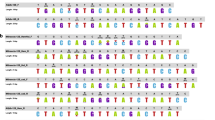Abstract
The classification and evolutionary relationships are important issues in the study of the groupers. Cytochrome b gene fragment of twenty-eight grouper species within six genera of subfamily Epinephelinae was amplified using PCR techniques and the sequences were analyzed to derive the phylogenetic relationships of the groupers from the China Seas. Genetic information indexes, including Kimura-2 parameter genetic distance and T S/T V ratios, were generated by using a variety of biology softwares. With Niphon spinosus, Pagrus major and Pagrus auriga as the designated outgroups, phylogenetic trees, which invoke additional homologous sequences of other Epinephelus fishes from GenBank, were constructed based on the neighbor-joining (NJ), maximum-parsimony (MP), maximum-likelihood (ML) and minimum-evolution (ME) methods. Several conclusions were drawn from the DNA sequences analysis: (1) genus Plectropomus, which was early diverged, is the most primitive group in the subfamily Epinephelinae; (2) genus Variola is more closely related to genus Cephalopolis than the other four genera; (3) genus Cephalopolis is a monophyletic group and more primitive than genus Epinephelus; (4) Promicrops lanceolatus and Cromileptes altivelis should be included in genus Epinephelus; (5) there exist two sister groups in genus Epinephelus.
Similar content being viewed by others
References
Heemstra P C, Randall J E. Groupers of the World. Rome: FAO Species Catalogue, 1993
Meng Q W, Su J X, Miao X Z. Fish Taxology (in Chinese). Beijing: China Agriculture Press, 1995
Cheng Q T, Zheng B S. Systematic Synopsis of Chinese Fishes (in Chinese). Beijing: Science Press, 1987
Irwin D M, Kocher T D, Wilson A C. Evolution of the cytochrome b gene of mammals. J Mol Evol, 1991, 32: 128–144
Zardoya R, Meyer A. Phylogenetic performance mitochondrial protein coding genes in resolving relationship among Vertebrates. Mol Biol Evol, 1996, 13: 933–942
He S P, Liu H Z, Chen Y Y, Kuwahara M, Nakajima T, Zhong Y. Molecular phylogenetic relationships of Eastern Asian Cyprinidae (Pisces: Cypriniformes) inferred from cytochrome b sequences. Sci China Ser C-life Sci, 2004, 47(2): 130–138
Song C B, Near T J, Page L M. Phylogenetic relations among percid fishes as inferred from mitochondrial cytochrome b DNA sequence data. Mol Phylogenet Evol, 1998, 10(3): 343–353
Caldara F, Bargelloni L, Ostellari L, Penzo E, Colombo L, Patarnello T. Molecular phylogeny of grey mullets based on mitochondrial DNA sequence analysis: Evidence of a differential rate of evolution at the intrafamily level. Mol Phylogenet Evol, 1996, 6(3): 416–424
Craig M T, Pondella D J, Franck J P, Hafner J C. On the status of the Serranid Fish genus Epinephelus: Evidence for paraphyly based upon 16S rDNA sequence. Mol Phylogenet Evol, 2001, 19: 121–130
Maggio T, Andaloro F, Hemida F. A molecular analysis of some Eastern Atlantic grouper from the Epinephelus and Mycteroperca genus. J Exp Mar Biol Ecol, 321(1): 83–92
Sambrook J, Fitch E, Maniatis T. Molecular Cloning: A Laboratory Manual. 2nd ed. New York: Cold Spring Harbor Laboratory Press, 1989
Meyer A, Kocher T D, Basasibwaki P, Wilson A C. Monophyletic origin of Lake Victoria cichlid fishes suggested by mitochondrial DNA sequences. Nature, 1990, 347: 550–553
Cantatore P, Roberti M, Pesole G, Ludovico A, Milella F, Gadaleta M N, Saccone C. Evolutionary analysis of cytochrome b sequences in some Perciformes: Evidence for a slower rate of evolution than in mammals. J Mol Evol, 1994, 39: 589–597.
Nicholas K B, Nicholas Jr H B, Deerfield D W II. GeneDoc: Analysis and visualization of genetic variation. EMBNEW News, 1997, 4: 14
Thompson J D, Gibson T J, Plewnia F. The Clustal_X windows interface: Flexible strategies ed for multiple sequences alignment aided by quality analysis tools. Nucleic Aci Res, 1997, 25: 4876–4882
Rozas J, Rozas R. DnaSP (DNA Sequence Polymorphism), Version 4.00. An integrated program for molecular population genetics and molecular evolution analysis. Bioinformatics, 1999, 15: 174–175
Kumar S, Tamura K, Nei M. MEGA (Molecular evolutionary genetics analysis), Version 3.0. Tempe: Arizona State University, 2001
Swofford D L. PAUP*4.0610: Phylogenetic Analysis Using Parsimony (*and other methods), beta version. Sunderland: Sinauer Associates, 2002
Felsenstein J. PHYLYIP (phylogeny inference package), Version 3.63. Washington: University of Washington, 1993
Hochachka P W, Mommsen T. Biochemistry and Molecular Biology of Fishes: Environmental and Ecological Biochemistry, Vol 2. London: Elsevier Science, 1993, 1–38
Herwerden L V, Davies C R, Choat J H. Phylogenetic and evolutionary perspectives of the Indo-Pacific grouper Plectropomus species on the Great Barrier Reef, Australia. J Fish Biol, 2002, 60: 1591–1596
Leis J M. Larval development in four species of Indo-Pacific coral trout Plectropomus (Pisces, Serranidae: Epinephilinae) with an analysis of the relationships of the genus. Bull Mar Sci, 1986, 38: 525–552
Smith C L. Family Serranidae. In: Fisher W, Bianchi G, Scott W B, eds. FAO species identification sheets for fisheries purposes. Eastern Central Atlantic, Fishing Areas 34, 47(part). Vols. 1–7. Rome: Food and Agriculture Organization of the United Nations, 1981
Smith C L. A revision of the American Groupers: Epinephelus and allied genera. Bull Am Mus Nat Hist, 1971, 146: 67–241.
Chow S, Kishino H. Phylogenetic relationships between tuna species of the genus Thunnus (Scombridae, Teleostei): incosistent implications from morphology, nuclear and mitochondrial genomes. J Mol Evol, 1995, 41: 741–748
Bostrom M A, Collette B B, Luckhurst B E, et al. Hybridization between two serranids, the coney (Cephalopholis fulva) and the creole-fish (Paranthias furcifer), at Bermuda. Fish Bull, 2002, 100(4): 651–661
Author information
Authors and Affiliations
Corresponding author
Additional information
These authors contributed equally to this work.
Rights and permissions
About this article
Cite this article
Ding, S., Zhuang, X., Guo, F. et al. Molecular phylogenetic relationships of China Seas groupers based on cytochrome b gene fragment sequences. SCI CHINA SER C 49, 235–242 (2006). https://doi.org/10.1007/s11427-006-0235-y
Received:
Accepted:
Issue Date:
DOI: https://doi.org/10.1007/s11427-006-0235-y




